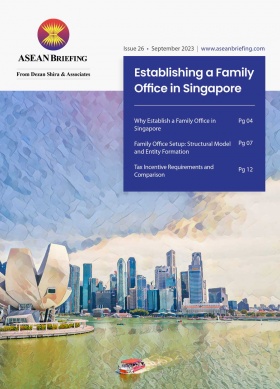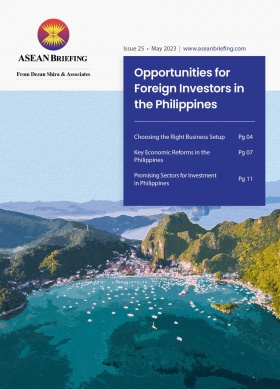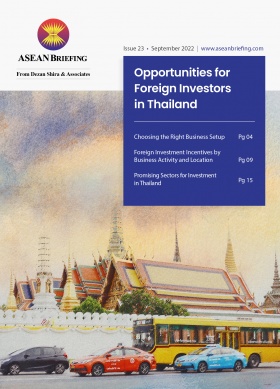Thailand’s Eastern Economic Corridor Sets New Investment Targets
Thailand’s Eastern Economic Corridor (EEC) has set a new investment target of 500 billion baht (US$13.7 billion) over the next five years.
The government’s new Commerce Minister pledged to address all long-standing obstacles within 99 days to better attract foreign investment into the EEC. This includes finalizing a key high-speed railway project that connects the EEC to three major airports: Suvarnabhumi, Don Mueang, and U-tapao. The 220-kilometer railway project is valued at 282 billion baht (US$7.7 billion).
To achieve its investment goals, the EEC will focus on developing electric vehicles, medical services, biotechnology infrastructure, and digital industries such as microchips and electronics. Between 2018-2022, the EEC attracted approximately 1.8 trillion baht (US$49.3 billion), exceeding the 1.7 trillion baht (US$46.6 billion) target.EEC is the centerpiece of Thailand’s economic growth
On February 1, 2018, the Thai parliament approved the law for trade and investment in the Eastern Economic Corridor (EEC). Through the EEC, Thailand hopes to develop its eastern provinces into a leading ASEAN economic zone. The EEC straddles three eastern provinces of Thailand – Chonburi, Rayong, and Chachoengsao – off the Gulf of Thailand coast and spans 13,285 square kilometers.
Thailand’s eastern seaboard already enjoys strong connectivity to neighboring countries and established trade routes. The seaboard has seen success in petrochemical, automobile, and electronic industries.
The framework of the EEC is specifically designed to accommodate Thailand’s 10 target industries and its ‘Thailand 4.0 initiative’ to attract foreign investment. The 10 target industries include five existing industries: Automotive, electronics, petrochemical, agriculture and food, and tourism as well as five new next-generation industries: Automation and robotics, aerospace, digital, biotechnology, and medical and healthcare.
A major focus of the EEC is to improve existing connectivity and foster manufacturing and innovation. The government envisions creating established sea routes from the eastern provinces of Thailand to Myanmar’s ongoing Dawei deep-sea port project, Cambodia’s Sihanoukville port, and Vietnam’s Vung Tau port. The government is expanding the Laem Chabang seaport – already the country’s biggest – with the goal of transforming it into a marine hub of Southeast Asia.
The Laem Chabang deep seaport began its Phase 3 expansion in 2023, valued at 30 billion baht (US$927 million). This will see the port have a container throughput capacity of 18 million twenty-foot equivalents (TEU) per year once completed in 2029.
The project, which involves the cooperation of the Port of Thailand Authority (PAT) and the GPC International Terminals consortium, aims to develop the Laem Chabang Port towards the world’s top 10 ports, complete with full automation management systems. The F1 and F2 container berths are expected to generate 8 billion baht (US$245 million) per year, collectively. The Laem Chabang Port is the world’s third-largest gateway port.
Available incentives
To attract foreign investors, the EEC offers an array of incentives including a flat personal income tax rate of 17 percent, corporate income tax exemption for up to 15 years, custom duty exemptions for the import of raw materials, easier process for hiring foreign employees, and the right to lease land for up to 50 years for residential development, and up to 99 years for commercial and industrial areas (50 years initially and 49 years on one-time renewal).
Thailand’s economic revival
Thailand’s GDP outlook is expected to grow between 2.7-3.6 percent in 2023, an increase from 2.6 percent in 2022. Economic growth will be boosted by a recovering tourism industry and improving private consumption.
The tourism sector rebounding
Tourism is an important sector for Thailand. The sector contributes to approximately 20 percent of GDP with a record 39 million international tourists visiting the country in 2019 before the onset of COVID-19. This brought US$64 billion to the economy.
Thailand is particularly eager to recapture the Chinese tourist market after China reopened its borders in early January. The government has targeted five million Chinese tourists this year, expected to contribute at least US$13 billion to the economy. Between January and May 2023, Thailand saw 9.47 million international tourists and will look to surpass 11.5 million foreign travelers that entered the country in the whole of 2022 – this figure dwindled to just 427,869 in 2021. Thailand is expected to see 25 million foreign visitors in 2023 and is aiming to generate US$71 billion in revenue.
About Us
ASEAN Briefing is produced by Dezan Shira & Associates. The firm assists foreign investors throughout Asia and maintains offices throughout ASEAN, including in Singapore, Hanoi, Ho Chi Minh City, and Da Nang in Vietnam, in addition to Jakarta, in Indonesia. We also have partner firms in Malaysia, the Philippines, and Thailand as well as our practices in China and India. Please contact us at asean@dezshira.com or visit our website at www.dezshira.com.








